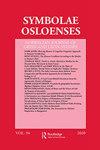Panegyrics, Poetry and Hair in the Late First and Early Second Century AD
IF 0.1
3区 历史学
0 CLASSICS
引用次数: 0
Abstract
This article confronts descriptions (1) in the Younger Pliny's panegyric to Trajan of the outward appearance of the empress Plotina with portraits showing the coiffures of Plotina and other women in high society, (2) in Statius' Silvae of the artfully arranged hair of young slaves with monuments showing such delicati. It is argued that these descriptions serve to emphasise the ability of those praised (the emperor and the recipients of Statius' poems) to shape and control the nature of others (Plotina and the delicati).公元一世纪末二世纪初的Panegyrics、Poetry和Hair
这篇文章面对的描述(1)在小普林尼对图拉真的赞美诗中,用普罗提娜和其他上流社会女性的发型肖像描绘了普罗提娜皇后的外表;(2)在Statius的Silvae中,用展示这种美味的纪念碑巧妙地排列了年轻奴隶的头发。有人认为,这些描述是为了强调那些被赞扬的人(皇帝和斯塔提斯诗歌的接受者)塑造和控制他人(普罗提纳和熟食店)本性的能力。
本文章由计算机程序翻译,如有差异,请以英文原文为准。
求助全文
约1分钟内获得全文
求助全文

 求助内容:
求助内容: 应助结果提醒方式:
应助结果提醒方式:


